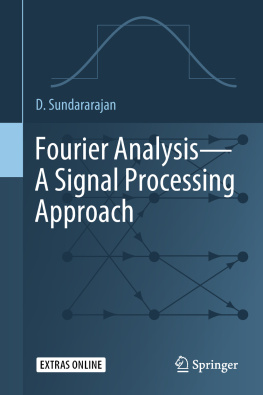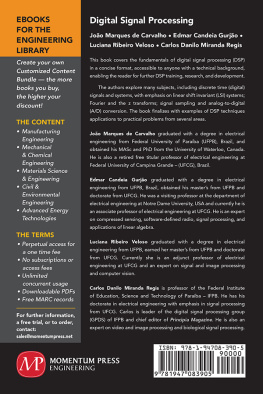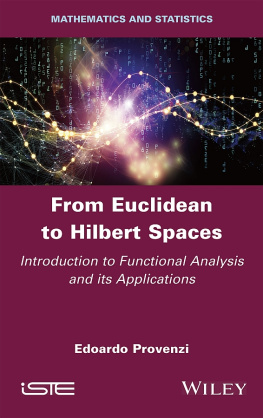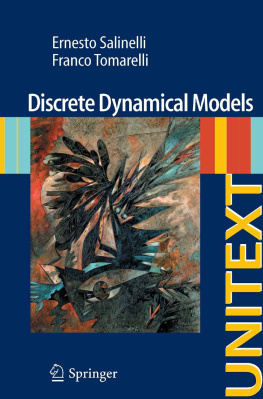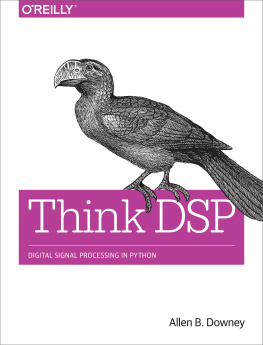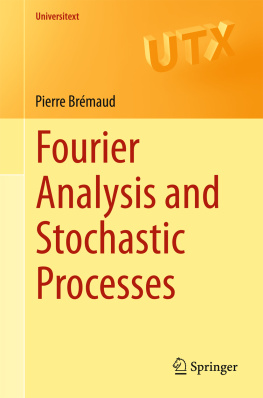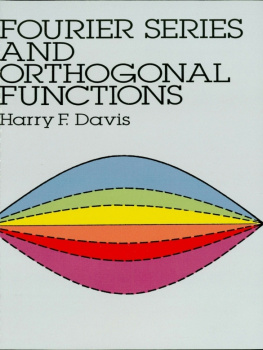D. Sundararajan
Formerly at Department of Electrical and Computer Engineering, Concordia University, Montreal, QC, Canada
ISBN 978-981-13-1692-0 e-ISBN 978-981-13-1693-7
https://doi.org/10.1007/978-981-13-1693-7
Library of Congress Control Number: 2018949334
Springer Nature Singapore Pte Ltd. 2018
This work is subject to copyright. All rights are reserved by the Publisher, whether the whole or part of the material is concerned, specifically the rights of translation, reprinting, reuse of illustrations, recitation, broadcasting, reproduction on microfilms or in any other physical way, and transmission or information storage and retrieval, electronic adaptation, computer software, or by similar or dissimilar methodology now known or hereafter developed.
The use of general descriptive names, registered names, trademarks, service marks, etc. in this publication does not imply, even in the absence of a specific statement, that such names are exempt from the relevant protective laws and regulations and therefore free for general use.
The publisher, the authors, and the editors are safe to assume that the advice and information in this book are believed to be true and accurate at the date of publication. Neither the publisher nor the authors or the editors give a warranty, express or implied, with respect to the material contained herein or for any errors or omissions that may have been made. The publisher remains neutral with regard to jurisdictional claims in published maps and institutional affiliations.
This Springer imprint is published by the registered company Springer Nature Singapore Pte Ltd.
The registered company address is: 152 Beach Road, #21-01/04 Gateway East, Singapore 189721, Singapore
Preface
Transform methods dominate the study of linear time-invariant systems in all the areas of science and engineering, such as circuit theory, signal/image processing, communications, controls, vibration analysis, remote sensing, biomedical systems, optics, acoustics. The heart of the transform methods is Fourier analysis. Several other often used transforms are generalizations or specific versions of Fourier analysis. It is unique in that it is much used in theoretical studies as well as in practice. The reason for the latter case is the availability of fast algorithms to approximate the Fourier spectrum adequately. For example, the existence and continuing growth of digital signal and image processing are due to the ability to implement the Fourier analysis quickly by digital systems. This book is written for engineering, computer science, and physics students, and engineers and scientists. Therefore, Fourier analysis is presented primarily using physical explanations with waveforms and/or examples, keeping the mathematical form to the extent it is necessary for its practical use. In engineering applications of Fourier analysis, its interpretation and use are relatively more important than rigorous proofs. Plenty of examples, figures, tables, programs, and physical explanations make it easy for the reader to get a good grounding in the basics of Fourier signal representation and its applications.
This book is intended to be a textbook for senior undergraduate- and graduate-level Fourier analysis courses in engineering and science departments and a supplementary textbook for a variety of application courses in science and engineering, such as circuit theory, communications, signal processing, controls, remote sensing, image processing, medical analysis, acoustics, optics, and vibration analysis. For engineering professionals, this book will be useful for self-study. In addition, this book will be a reference for anyone, student or professional, specializing in the practical applications of Fourier analysis. The prerequisite for reading this book is a good knowledge of calculus, linear algebra, signals and systems, and programming at the undergraduate level.
Programming is an important component in learning and practicing Fourier analysis. A set of MATLAB programs are available at the Web site of the book. While the use of a software package is inevitable in most applications, it is better to use the software in addition to self-developed programs. The effective use of a software package or to develop own programs requires a good grounding in the basic principles of the Fourier analysis. Answers to the selected exercises marked are given at the end of the book. A Solutions Manual and slides are available for instructors at the Web site of the book.
I assume the responsibility for all the errors in this book and would very much appreciate receiving readers suggestions and pointing out any errors (email: d_sundararajan:yahoo.com). I am grateful to my Editor and the rest of the team at Springer for their help and encouragement in completing this project. I thank my family for their support during this endeavor.
D. Sundararajan
Abbreviations
1-D
One-dimensional
2-D
Two-dimensional
DC
Sinusoid with frequency zero, constant
DFT
Discrete Fourier transform
DIF
Decimation in frequency
DIT
Decimation in time
DTFT
Discrete-time Fourier transform
FIR
Finite impulse response
FS
Fourier series
FT
Fourier transform
IDFT
Inverse discrete Fourier transform
IFT
Inverse Fourier transform
LSB
Least significant bit
LTI
Linear time-invariant
PM
Plusminus
RDFT
DFT of real-valued data
RIDFT
IDFT of the transform of real-valued data
Contents
Appendix A: Transform Pairs and Properties
Appendix B: Useful Mathematical Formulas
Bibliography
Answers to Selected Exercises
Index
About the Author
Dr. D. Sundararajan
holds a B.E. in electrical engineering from Madras University and an M.Tech. in electrical engineering from the Indian Institute of Technology Madras (IIT Madras). He obtained his Ph.D. in electrical engineering from Concordia University, Montreal, Canada, in 1988. As the principal inventor of the latest family of discrete Fourier transform (DFT) algorithms, he holds three patents (granted by the USA, Canada, and Britain). Further, he has published several papers in IEEE Transactions and in the Proceedings of the IEEE, and he is the author of five books. He has taught undergraduate and graduate students in digital signal processing, digital image processing, engineering mathematics, programming, operating systems, and digital logic design at Concordia University, Canada; Nanyang Technological University, Singapore; and Adhiyamaan College of Engineering, India. He has also conducted workshops on digital image processing, MATLAB, and LaTeX.
Over the course of his engineering career, he has held positions at the National Aerospace Laboratory, Bangalore, and the National Physical Laboratory, New Delhi, where he worked on the design of digital and analog signal processing systems.
Springer Nature Singapore Pte Ltd. 2018
D. Sundararajan Fourier AnalysisA Signal Processing Approach https://doi.org/10.1007/978-981-13-1693-7_1
1. Signals
D. Sundararajan
(1)
Formerly at Department of Electrical and Computer Engineering, Concordia University, Montreal, QC, Canada

